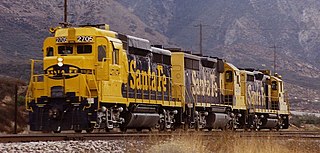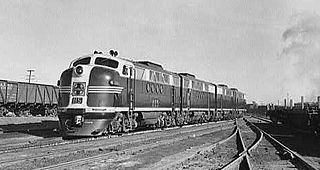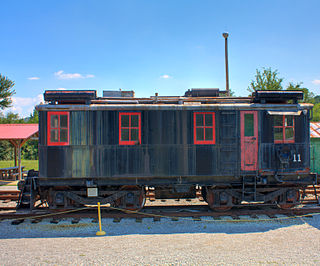
The American Locomotive Company was an American manufacturer of locomotives, diesel generators, steel, and tanks that operated from 1901 to 1969.

A diesel locomotive is a type of railway locomotive in which the power source is a diesel engine. Several types of diesel locomotives have been developed, differing mainly in the means by which mechanical power is conveyed to the driving wheels. The most common are diesel-electric locomotives and diesel-hydraulic.

The EMD GP30 is a 2,250 hp (1,680 kW) four-axle diesel-electric locomotive built by General Motors Electro-Motive Division of La Grange, Illinois between July 1961 and November 1963. A total of 948 units were built for railroads in the United States and Canada, including 40 cabless B units for the Union Pacific Railroad.

The EMD FT is a 1,350-horsepower (1,010 kW) diesel-electric locomotive that was produced between March 1939 and November 1945, by General Motors' Electro-Motive Corporation (EMC), later known as GM Electro-Motive Division (EMD). The "F" stood for Fourteen Hundred (1400) horsepower and the "T" for Twin, as it came standard in a two-unit set. The design was developed from the TA model built for the C,RI&P in 1937, and was similar in cylinder count, axle count, length, and layout. All told 555 cab-equipped ”A” units were built, along with 541 cabless booster or ”B” units, for a grand total of 1,096 units. The locomotives were all sold to customers in the United States. It was the first model in EMD's very successful F-unit series of cab unit freight diesels and was the locomotive that convinced many U.S. railroads that the diesel-electric freight locomotive was the future. Many rail historians consider the FT one of the most important locomotive models of all time.
Early Electro-Motive Corporation switcher locomotives were built with Winton 201-A engines. A total of 175 were built between February 1935 and January 1939. Two main series of locomotives were built, distinguished by engine size and output: the straight-8, 600 hp (450 kW) 'S' series, and the V12, 900 hp (670 kW) 'N' series. Both were offered with either one-piece cast underframes from General Steel Castings of Granite City, Illinois, denoted by 'C' after the power identifier, and fabricated, welded underframes built by EMC themselves, denoted by 'W'. This gave four model series: SC, SW, NC and NW. Further developments of the 900 hp (670 kW) models gave model numbers NC1, NC2, NW1, and NW1A, all of which were practically indistinguishable externally from the others, as well as a pair of unique NW4 models for the Missouri Pacific Railroad and a solitary, twin-engined T transfer locomotive model built for the Illinois Central Railroad.

The ALCO S-1 and S-3 were 660 horsepower (490 kW) diesel-electric switcher locomotives produced by ALCO and their Canadian subsidiary Montreal Locomotive Works (MLW). The two locomotives differed only in trucks, with the S-1 using ALCO's own Blunt trucks, and the S-3 using AAR type A switcher trucks. The S-1 was built between April 1940 and June 1950, with a total of 543 completed, while the S-3 was constructed between February 1950 and November 1953 with total sales of 300. A modified version, the S-10, was built by MLW only; 13 were built between January and June 1958.

The ALCO HH series was an early set of diesel switcher locomotives built by the American Locomotive Company (ALCO) of Schenectady, New York between 1931 and 1940, when they were replaced by the S series: the 660 hp (490 kW) S-1 and 1,000 hp (750 kW) S-2. They were ALCO's first diesel switchers to enter true series production, and among the first land vehicles anywhere to use the revolutionary diesel-electric power transmission.

The ALCO PA was a family of A1A-A1A diesel locomotives built to haul passenger trains. The locomotives were built in Schenectady, New York, in the United States, by a partnership of the American Locomotive Company (ALCO) and General Electric (GE) between June, 1946 and December, 1953. Designed by General Electric's Ray Patten, they were of a cab unit design; both cab-equipped lead A unit PA and cabless booster B unit PB models were built. While externally the PB models were slightly shorter than the PA model, they shared many of the same characteristics, both aesthetically and mechanically. However, they were not as reliable as EMD E-units.

The ALCO RS-2 is a 1,500–1,600 horsepower (1,100–1,200 kW) B-B diesel-electric locomotive built by the American Locomotive Company (ALCO) from 1946 to 1950. ALCO introduced the model after World War II as an improvement on the ALCO RS-1. Between 1946 and 1950, 377 examples of the RS-2 were built, primarily for American and Canadian customers.

The ALCO Century 420 is a four-axle, 2,000 horsepower (1,491 kW) diesel-electric locomotive. 131 were built between June 1963 and August 1968. Cataloged as a part of ALCO's "Century" line of locomotives, the C420 was intended to replace the earlier RS-32 model.

Baldwin Locomotive Works produced several different Baldwin DR-6 models of 6-axle passenger train-hauling diesel locomotives between 1945 and 1948. The series comprised eight individual versions, all of which sold only in small numbers; across all versions, only 39 locomotives were produced. Each version was produced only for a single railroad. Many shared the same Baldwin model number, DR-6-4-2000, even though they were rather different; this was because the Baldwin model only encoded the total axles (6), the driven axles (4) and the power output. The single exception was the single unit produced for the Chicago and North Western Railway, which had a single 1,000 hp (750 kW) engine and was model number DR-6-2-1000. In the AAR wheel arrangement scheme of classification, these locomotives were of A1A-A1A and A1A-3 arrangements, respectively.

The ALCO boxcabs were diesel-electric switcher locomotives, otherwise known as AGEIR boxcabs as a contraction of the names of the builders. Produced by a partnership of three companies, ALCO built the chassis and running gear, General Electric the generator, motors and controls, and Ingersoll Rand the diesel engine. The principle of operation was the same as modern locomotives, the diesel engine driving a main generator of 600 volts DC with four traction motors, one per axle.

The ALCO FA was a family of B-B diesel locomotives designed to haul freight trains. The locomotives were built by a partnership of ALCO and General Electric in Schenectady, New York, between January 1946 and May 1959. Designed by General Electric's Ray Patten, they were of a cab unit design; both cab-equipped lead FA and cabless booster FB models were built. A dual passenger-freight version, the FPA/FPB, was also offered. It was equipped with a steam generator for heating passenger cars.
The ALCO DL-202-2 and DL-203-2 diesel-electric locomotive was an experimental freight locomotive produced by ALCO of Schenectady, New York. The primary diesel builders Alco, Baldwin and EMD pushed the War Production Board (WPB) for more opportunities to build more diesels. The Transportation Equipment Division of the WPB announced a production schedule on December 10, 1943, that allowed Alco to build one 4500 horsepower experimental diesel locomotive. This experimental diesel locomotive was to be built in the fourth quarter of 1944. The two A units were built in January 1945 and the B unit at a later date in 1945. The two A units were put on test at Building No. 37 at Schenectady to work out problems with the connecting rods and turbocharger in the Alco 241 engine, developed by both McIntosh and Seymour and ALCo. The total production run included 2 cab DL202-2 A units, and a single DL203-2 B unit. The locomotives were powered by a V12 ALCO 241 diesel engine, rated at 1,500 hp (1.1 MW). The units were released for test in September 1945. The locomotive could attain a top speed of 80 mph (130 km/h) (Freight) and 125 mph (201 km/h) (Passenger). With the B-B wheel arrangement and carbody construction, equipment layout and electrical gear these experimental units were the immediate predecessors of the FA units to come in early 1946. Outwardly, the bodies strongly resembled those on the DL-109, some of which were still under construction at Schenectady in early 1945.

The ALCO RS-3m is a diesel-electric locomotive rebuilt from an ALCO RS-3 road switcher. These 98 locomotives were rebuilt to replace their original ALCO prime mover with the more reliable EMD 567B engine and fan assemblies taken from retired E8s. Many of these rebuilds were performed by the ex NYC DeWitt shop with 56 completed at the ex PRR Juniata shop. The RS3m rebuild program started in 1972 and continued until 1978 under Conrail.

The Krauss-Maffei ML 4000 is a road switcher diesel-hydraulic locomotive, built between 1961 and 1969 by German manufacturer Krauss-Maffei in Munich, Germany. It generated 3,540 horsepower (2,640 kW) from two Maybach V16 engines. 37 examples were built for two North American railroads and one South American railroad.
The ALCO 251 is a 4-stroke diesel engine that was developed by the American Locomotive Company to replace its 244 and 539 engines. The 251 was developed to be used in diesel locomotives, as a marine power plant in ships, and as a stationary power generator.

The GE boxcabs, sometimes also GE IR boxcabs, were diesel-electric switcher locomotives succeeding the ALCO boxcabs. The locomotives were built by General Electric and Ingersoll Rand without ALCO. Production lasted from 1928 to 1930. These boxcabs were often termed oil-electrics to avoid the use of the German name Diesel, unpopular after World War I.
Maine Central Railroad began operating diesel locomotives in 1935, and had retired all steam locomotives by 1954. That time interval was a joint operating period with the Boston and Maine Railroad (B&M). This article describes diesel locomotives owned by Maine Central through the period of joint operation and later independent operation prior to Guilford Rail System control in 1981.
The McIntosh & Seymour 531 was a diesel prime mover built by McIntosh & Seymour for use in railroad locomotives built by its parent company, the American Locomotive Company (Alco).















